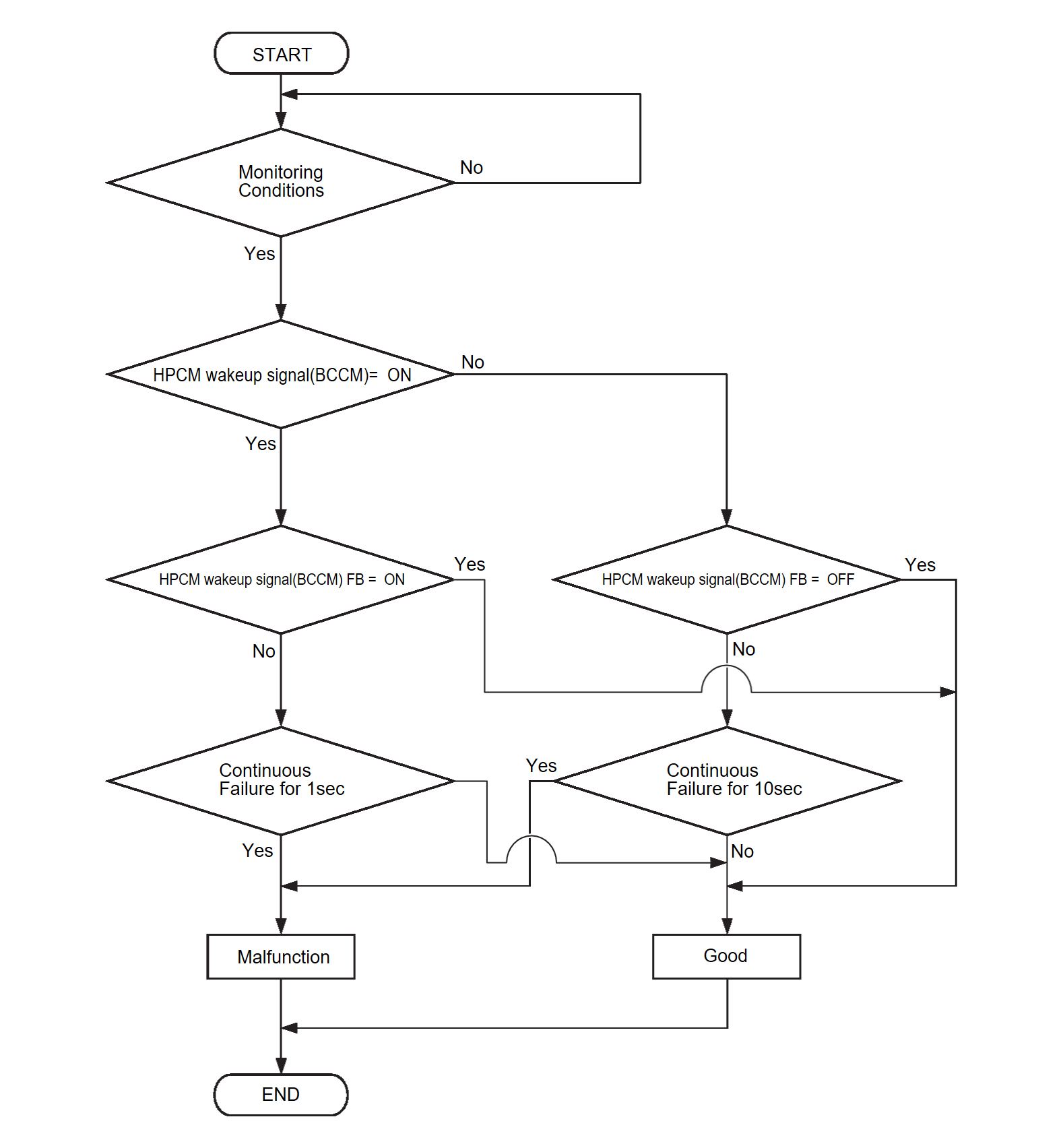DTC No. P1C64-29: Start Request Signal failure of OBC
MONITOR EXECUTION
Continuous
MONITOR EXECUTION CONDITIONS (Other monitor and Sensor)
Other Monitor (There is no temporary DTC set in memory for the item monitored below)
- On Board Charger (OBC) monitor
- EV CAN monitor
Sensor (The sensor below is determined to be normal)
- Not applicable
Check Condition A
- PHEV-ECU wakeup signal (On Board Charger (OBC)/DC-DC converter): ON
- The On Board Charger (OBC)/DC-DC converter power supply voltage is 10.0 to 16.0 volts.
Check Condition B
- PHEV-ECU wakeup signal (On Board Charger (OBC)/DC-DC converter): OFF
- The On Board Charger (OBC)/DC-DC converter power supply voltage is 10.0 to 16.0 volts.
Judgment Criterion A
- The PHEV-ECU wakeup signal (On Board Charger (OBC)/DC-DC converter) is in OFF condition for 1 second or more.
Judgment Criterion B
- The PHEV-ECU wakeup signal (On Board Charger (OBC)/DC-DC converter) is in ON condition for 10 seconds or more.
OBD-II DRIVE CYCLE PATTERN
- Refer to OBD-II Drive Cycle OBD-II DRIVE CYCLE
 .
.
TROUBLESHOOTING HINTS
- Damaged wiring harness and connectors
- Malfunction of the PHEV-ECU
- Malfunction of the On Board Charger (OBC)/DC-DC converter
DIAGNOSIS
Required Special Tools:
- MB992744: Vehicle communication interface-Lite (V.C.I.-Lite)
- MB992745: V.C.I.-Lite main harness A
- MB992747: V.C.I.-Lite USB cable short
- MB992748: V.C.I.-Lite USB cable long
- MB991223: Wiring harness set
- MB992006: Extra fine probe
1.Voltage measurement at On Board Charger (OBC)/DC-DC converter (charge start signal line).
(1) Disconnect the connector, and measure at the wiring harness side.
(2) Measure the voltage between the following terminals.
- Voltage between On Board Charger (OBC)/DC-DC converter (No. 2 terminal) and body ground
OK: Battery voltage
Is the check result normal?
2.Check of short to ground circuit and open circuit between On Board Charger (OBC)/DC-DC converter and PHEV-ECU (charge start signal line).
Check the following wiring harness for short to ground circuit and open circuit.
- Short to ground circuit and open circuit between On Board Charger (OBC)/DC-DC converter connector (No. 5 terminal) and PHEV-ECU connector (CHGP terminal)
Is the check result normal?
3.Voltage measurement at PHEV-ECU connector (CHGP line).
(1) Measure the PHEV-ECU connector (B508) by backprobing.
(2) Change the power supply mode of the electric motor switch to OFF, then wait for 2 minutes or more in key lock condition. (Check that the P indicator on the selector lever turns off.)
(3) After changing the power supply mode of the electric motor switch to ON (READY indicator: OFF), measure the volatge between the following terminals for approximately 3 seconds.
- Voltage between PHEV-ECU connector (B508) (CHGP terminal) and body goruind
OK: 1.5 V or less
Is the check result normal?
4.Test the OBD-II drive cycle.
(1) Carry out a test drive with the drive cycle pattern. Refer to OBD-II Drive Cycle OBD-II DRIVE CYCLE .
.
 .
.(2) Check the DTC.
Is the DTC set?
 Replace the On Board Charger (OBC)/DC-DC converter (Refer to ON BOARD CHARGER (OBC) &DC-DC CONVERTER REMOVAL AND INSTALLATION
Replace the On Board Charger (OBC)/DC-DC converter (Refer to ON BOARD CHARGER (OBC) &DC-DC CONVERTER REMOVAL AND INSTALLATION ). Then,
). Then, 
 The trouble can be an intermittent malfunction (Refer to General Information - How to Use Troubleshooting/Inspection Service Points, How to Cope with Intermittent Malfunctions HOW TO COPE WITH INTERMITTENT MALFUNCTIONS
The trouble can be an intermittent malfunction (Refer to General Information - How to Use Troubleshooting/Inspection Service Points, How to Cope with Intermittent Malfunctions HOW TO COPE WITH INTERMITTENT MALFUNCTIONS ).
).5.Test the OBD-II drive cycle.
(1) Carry out a test drive with the drive cycle pattern. Refer to OBD-II Drive Cycle OBD-II DRIVE CYCLE .
.
 .
.(2) Check the DTC.
Is the DTC set?
 Replace the PHEV-ECU (Refer to PHEV-ECU REMOVAL AND INSTALLATION
Replace the PHEV-ECU (Refer to PHEV-ECU REMOVAL AND INSTALLATION ). Then,
). Then, 
 The trouble can be an intermittent malfunction (Refer to General Information - How to Use Troubleshooting/Inspection Service Points, How to Cope with Intermittent Malfunctions HOW TO COPE WITH INTERMITTENT MALFUNCTIONS
The trouble can be an intermittent malfunction (Refer to General Information - How to Use Troubleshooting/Inspection Service Points, How to Cope with Intermittent Malfunctions HOW TO COPE WITH INTERMITTENT MALFUNCTIONS ).
).6.Test the OBD-II drive cycle.
(1) Carry out a test drive with the drive cycle pattern. Refer to OBD-II Drive Cycle OBD-II DRIVE CYCLE .
.
 .
.(2) Check the DTC.
Is the DTC set?
 Retry the troubleshooting.
Retry the troubleshooting. The procedure is complete.
The procedure is complete.![[Previous]](../../../buttons/fprev.png)
![[Next]](../../../buttons/fnext.png)
